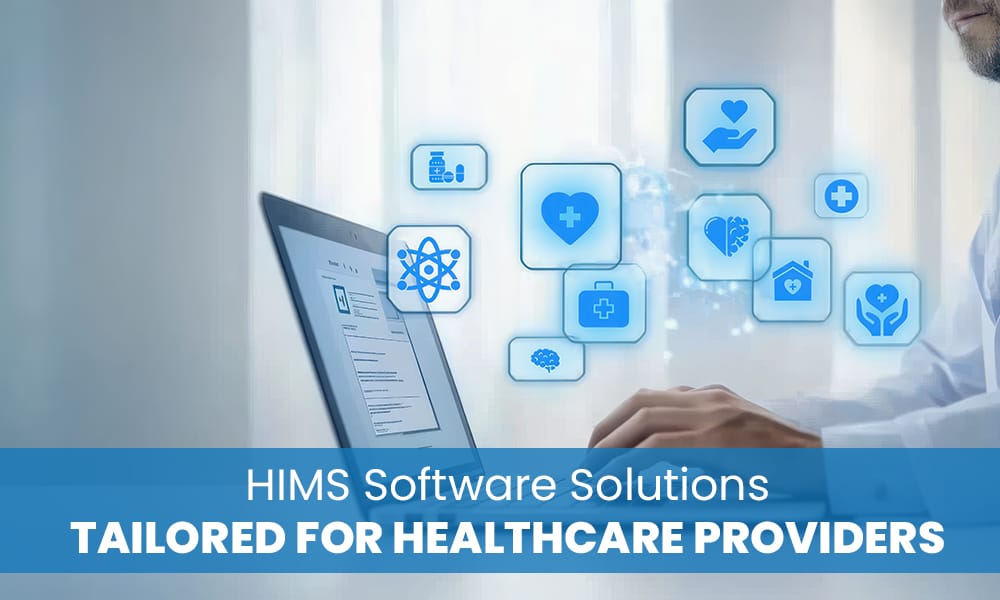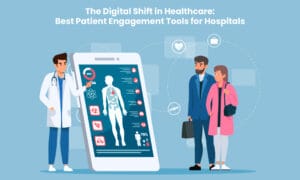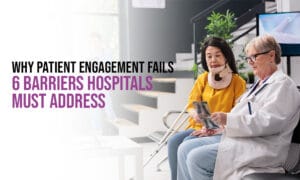
The healthcare industry is undergoing rapid transformation. By 2025, digital health systems are not a luxury—they are a necessity. Hospitals and clinics face growing patient loads, stricter regulations, and the need to deliver faster, data-backed decisions. At the core of this shift lies HIMS software, a toolset revolutionising healthcare infrastructure.
The Rise of HIMS Software in Modern Healthcare
HIMS software (Hospital Information Management System) enables clinics and hospitals to centralise data, streamline operations, and improve patient outcomes. It digitises every function—from patient admission and diagnosis to billing, pharmacy, and discharge. It creates a unified digital backbone that ensures seamless data sharing across departments.
Its integration with remote patient monitoring technologies makes it an invaluable solution. With real-time alerts, hospitals can detect emergencies before they become critical. From vital signs to medication adherence, remote patient monitoring empowers clinicians with proactive care capabilities.
Why 2025 Is a Turning Point for HIMS and Digital Care?
Technology is changing the healthcare delivery model. We’re moving from reactive treatment to proactive and preventive care. That’s where telehealth software fits into the puzzle. It bridges the gap between in-person visits and virtual consultations. When HIMS software integrates with telehealth software, providers can offer continuous care, even outside the hospital.
As the healthcare landscape continues evolving, healthcare monitoring systems become essential. These systems do more than just collect data—they turn it into actionable intelligence. Hospitals using these integrated systems see higher efficiency, reduced wait times, and improved diagnostics.

Tailoring HIMS Software to Fit Every Provider
Not all hospitals are built the same. A small rural clinic doesn’t require the same digital tools as a multispecialty metropolitan hospital. That’s why tailored solutions are crucial. HIMS software for remote patient monitoring can be configured to meet the specific needs of any healthcare provider—regardless of size or speciality.
For example, an orthopaedic clinic might prioritise imaging integration, while a maternity hospital might need enhanced scheduling and vaccination tracking. When healthcare providers select a solution that fits their unique processes, they unlock higher productivity.
Tailoring allows seamless integration of patient data from wearable devices. It enables remote patient monitoring with HIMS software, turning each patient into a real-time data source. Healthcare professionals then gain a complete view of the patient journey.
Benefits of Customised HIMS Software in 2025
A one-size-fits-all approach no longer works. Customisable HIMS software addresses unique challenges while maximising ROI. Here’s how:
• Operational Efficiency
Customised HIMS software significantly enhances operational efficiency by automating repetitive administrative tasks such as patient scheduling, billing, lab requests, and discharge processes. This streamlined approach reduces manual errors, saves time, and allows staff to focus on patient care.
By integrating telehealth software and healthcare monitoring systems, facilities can further improve workflows by synchronising patient data in real-time. When remote patient monitoring is built into the HIMS software, clinicians can manage more cases efficiently without physical interactions. Ultimately, the best HIMS software for RPM improves turnaround times and resource utilisation across departments.
• Improved Compliance
Hospitals and clinics face increasing regulatory scrutiny. Customised HIMS software ensures full compliance by centralising electronic health records and maintaining detailed audit trails. This helps in meeting HIPAA guidelines and supports seamless reporting for accreditation and inspections. With features that integrate telehealth software and healthcare monitoring systems, compliance also extends to virtual consultations and remote patient care.
Remote patient monitoring with HIMS software provides traceable logs for each interaction, including alerts and decision-making. By using HIMS software for remote patient monitoring, healthcare providers can prove due diligence and maintain consistent compliance even in distributed care environments.
• Patient Satisfaction
Patient satisfaction rises when care is fast, seamless, and accurate. HIMS software plays a crucial role in reducing wait times by automating appointment slots, lab orders, and result notifications. It also improves diagnostics by integrating with healthcare monitoring systems and telehealth software, allowing timely consultations and treatment adjustments.
Remote patient monitoring with HIMS software gives patients the flexibility to be monitored from home, which reduces hospital visits and promotes comfort. When healthcare providers implement the best HIMS software for RPM, patients feel more involved, better informed, and highly satisfied with their ongoing care experience.
• Clinical Accuracy
Medical decisions rely heavily on timely access to complete, up-to-date patient histories. Customised HIMS software ensures that doctors can instantly access lab results, prescriptions, imaging reports, and real-time vitals. This accuracy is amplified when combined with remote patient monitoring and telehealth software, enabling real-time symptom tracking from patients’ homes.
The best HIMS software for RPM collects continuous data through integrated healthcare monitoring systems, minimising diagnostic gaps and medication errors. Clinical accuracy ensures that treatments are appropriate and effective, which not only improves patient outcomes but also reduces the likelihood of costly readmissions or procedural redundancies.
• Data Security
In 2025, data security is non-negotiable. Customised HIMS software ensures that patient records are protected through advanced encryption, access controls, and HIPAA-compliant cloud infrastructure. As healthcare providers increasingly rely on telehealth software and remote patient monitoring, secure integration becomes crucial. The best HIMS software for RPM includes robust protection for data transmitted via healthcare monitoring systems, ensuring it’s safe from breaches and unauthorised access.
This security builds patient trust and protects institutions from legal consequences. Remote patient monitoring with HIMS software also requires secured endpoints, ensuring that all personal health information is stored and transferred responsibly.
Impact on Doctors, Nurses, and Patients
The greatest impact of HIMS is its human effect. Doctors no longer scramble for files. Everything they need—test results, scans, vitals—is in one place. Nurses manage less paperwork and more patient care. Patients feel heard, informed, and involved.
With remote patient monitoring, patients are no longer passive. They engage through apps that sync with the hospital database. When data connects through HIMS software, physicians can intervene earlier and with better context.
This shift to digital-first care improves long-term health outcomes. The use of telehealth software ensures that patients in rural or underserved areas receive timely consultations, follow-ups, and diagnostics without delays. This interconnected approach reduces hospital readmissions and improves preventive care.
The ROI of Implementing Customised HIMS Software
Every hospital wants to reduce costs, increase efficiency, and improve patient outcomes. Customised HIMS software offers all three. Let’s break down the ROI:
1) Short-Term Gains
• Reduced Admin Time: Automated billing and patient management.
• Faster Turnaround: Real-time updates in patient records.
• Fewer Errors: Alerts for drug interactions, missed appointments.
2) Long-Term Gains
• Increased Revenue: More patients served, less time wasted.
• Better Patient Retention: Enhanced experience leads to loyalty.
• Data-Driven Decisions: Analytics improve strategic planning.
Hospitals using HIMS software for remote patient monitoring report fewer emergency admissions and lower costs. Real-time vitals and predictive alerts prevent complications. Remote patient monitoring with HIMS software ensures that doctors can provide personalized treatment plans based on real data, not just assumptions.
| S.NO | Outcome Category | Short-Term ROI / Efficiency Gain | Long-Term ROI / Financial Impact |
| 1 | Reduced admin time / Transcription | ~28% immediate reduction in data-entry time | Ongoing staff productivity gains |
| 2 | Faster turnaround / Length of stay | 0.89 days per inpatient stay shorter | Cost savings on bed-days, meals, and staff time |
| 3 | Fewer errors (CPOE) | Medication errors ↓ 80%, serious errors ↓ 55% | $5–10M/year saved; $11.4M combined savings |
| 4 | Operational efficiency (EHR-BI) | Improved efficiency in weeks/months | Net ROI over 3 years meets industry benchmarks |
| 5 | Clinical productivity (VPU) | +30% revenue per clinician within 3 months | Sustained productivity and compliance |
| 6 | eCR expansion ROI | Year 1: 21% ROI | 5-year ROI: 142%, NPV: $7,166 |
| 7 | Patient outcome predictions | Reduction in LOS (0.67 days), readmissions ↓ 10–28.7% | $55–72M/year in system-wide savings |
This table summarises research-backed short- and long-term ROI benefits of customised HIMS software. Short-term gains include up to 28% reduction in admin work, quicker patient turnaround, and drastic error minimisation. Over the long term, hospitals experience higher revenues, significant cost savings, and better patient outcomes.
Studies show multi-million-dollar annual savings and a 142% five-year ROI. These metrics highlight how customised HIMS solutions improve efficiency, staff productivity, and strategic decision-making for healthcare providers
Why RPM and Telehealth Must Integrate with HIMS?
The fusion of remote patient monitoring, telehealth software, and HIMS software drives the new digital care model. It creates continuity across home care, virtual visits, and in-hospital treatments.
Healthcare monitoring systems capture continuous health data—BP, heart rate, oxygen saturation. These get pushed into the hospital’s HIMS dashboard. Doctors can act on anomalies instantly. Nurses receive alerts for deteriorating vitals. Patients get automatic reminders for medication or physical activity.
This data-driven synergy leads to fewer hospitalisations and improved chronic care management. Providers who implement the best HIMS software for RPM gain a competitive edge—both in patient outcomes and operational efficiency.
Selecting the Right HIMS Software: What to Look For
Choosing a system that works isn’t enough. You need one that thrives in your environment. Here’s a checklist for hospitals and clinics:
• Modular Architecture – Add or Remove Features as Needed
A modular HIMS software allows healthcare providers to tailor functionalities based on specific operational needs. Hospitals can easily plug in new features like remote patient monitoring modules or advanced analytics tools without rebuilding the entire system. This adaptability supports growth, improves workflows, and aligns perfectly with modern healthcare monitoring systems.
• Mobile Access – Doctors and Staff Can Use It on Tablets/Phones
Modern care requires mobility. A HIMS software with mobile access enables doctors and nurses to review patient records, schedule appointments, and access remote patient monitoring data through smartphones or tablets. When integrated with telehealth software, it creates a seamless digital environment, increasing efficiency and enhancing real-time healthcare monitoring systems.

• Integration Ready – Syncs with Lab Systems, Pharmacies, RPM Tools
A good HIMS software must integrate smoothly with labs, pharmacies, billing platforms, and especially remote patient monitoring devices. Integration with telehealth software ensures a 360-degree patient view, reducing manual data entry and improving data consistency across all healthcare monitoring systems, driving efficiency in diagnosis and treatment plans.
• Custom Reporting – Dashboards to Track KPIs
Hospitals need actionable insights. HIMS software with custom reporting helps track KPIs like patient wait time, billing cycles, and outcomes from remote patient monitoring systems. By combining these insights with telehealth software, administrators can improve performance and planning, using real-time data from all connected healthcare monitoring systems.
• Security Protocols – GDPR/HIPAA-Compliant
Data security is non-negotiable in healthcare. A reliable HIMS software must follow strict protocols like HIPAA and GDPR. Especially when managing telehealth software or remote patient monitoring data, security compliance ensures confidentiality, patient trust, and legal protection—keeping all healthcare monitoring systems safeguarded against breaches and unauthorised access.
• Unified Experience – Seamless Telehealth & RPM Integration
Hospitals should prioritise HIMS software for remote patient monitoring that integrates with telehealth software to ensure continuity of care. A unified digital ecosystem reduces data silos, improves patient engagement, and provides real-time access to critical health stats from all healthcare monitoring systems, ensuring effective coordination across departments.
Steps to Successfully Implement HIMS Software
• Needs Assessment
A thorough needs assessment helps identify workflow inefficiencies and system gaps. This ensures the selected HIMS software and healthcare monitoring systems meet actual care delivery and remote patient monitoring needs.
• Stakeholder Involvement
Involving doctors, nurses, and IT teams ensures the HIMS software for remote patient monitoring aligns with clinical workflows, making telehealth software implementation smoother and more effective.
• Pilot Program
Launching remote patient monitoring with HIMS software in a single department first allows performance testing. This reduces risk and fine-tunes the system before full-scale deployment in the hospital.
• Training Sessions
Hands-on training ensures healthcare staff fully utilise the best HIMS software for RPM, improving compliance, accuracy, and engagement in telehealth software and healthcare monitoring systems usage.
• Ongoing Support
24/7 vendor support ensures that HIMS software and remote patient monitoring services continue without disruption, enhancing user confidence and optimising the return on healthcare monitoring systems.
Final Thoughts: A Smarter Future for Smarter Healthcare Providers
The demand for efficient, responsive, and patient-centric care is at an all-time high. Customised HIMS software offers hospitals and clinics the chance to lead this transformation. From streamlined workflows to better diagnoses, from improved communication to measurable ROI—every benefit counts.
The integration of telehealth software and healthcare monitoring systems with HIMS software isn’t optional anymore—it’s a must-have strategy. And with growing reliance on data for care decisions, remote patient monitoring will continue to be the cornerstone of proactive healthcare.
If you’re a healthcare provider looking to future-proof your operations, start with the right foundation. Invest in the best HIMS software for RPM. Because in 2025 and beyond, smart healthcare isn’t about treating illness—it’s about predicting and preventing it.





